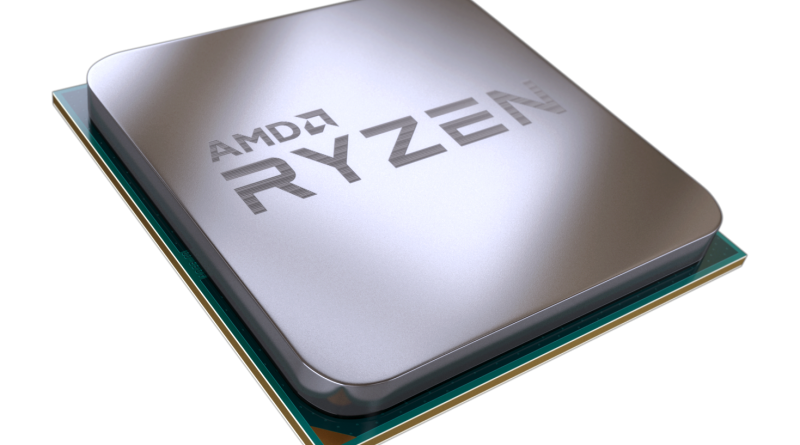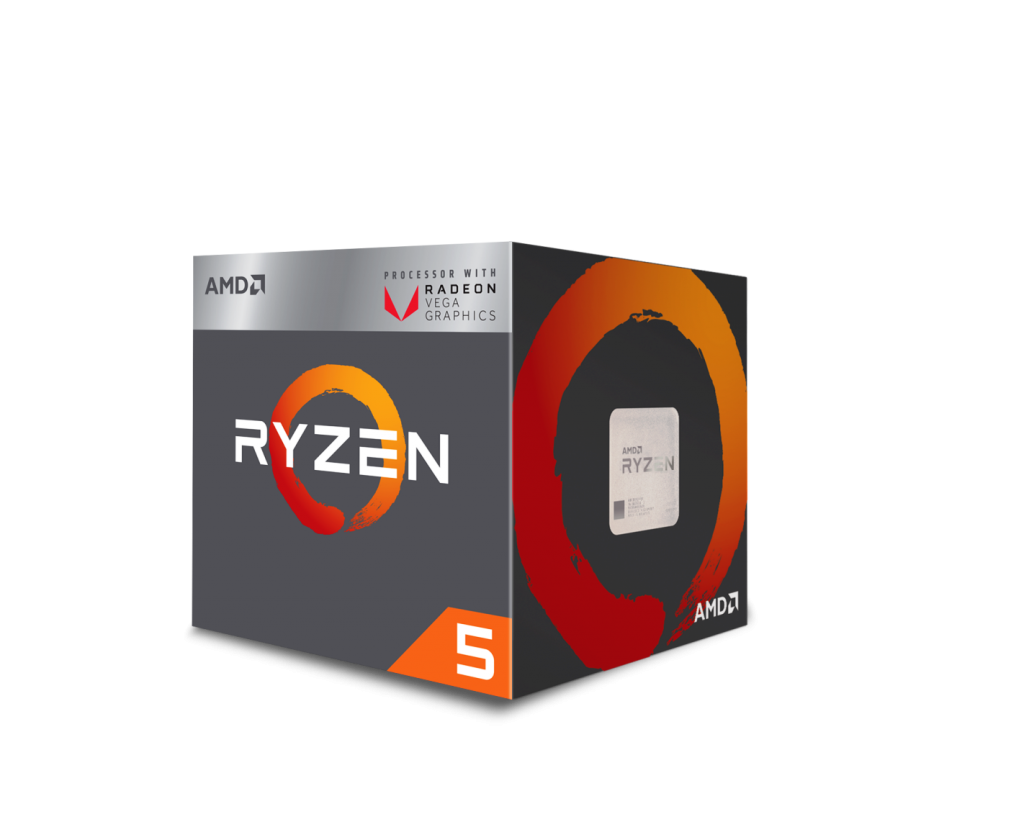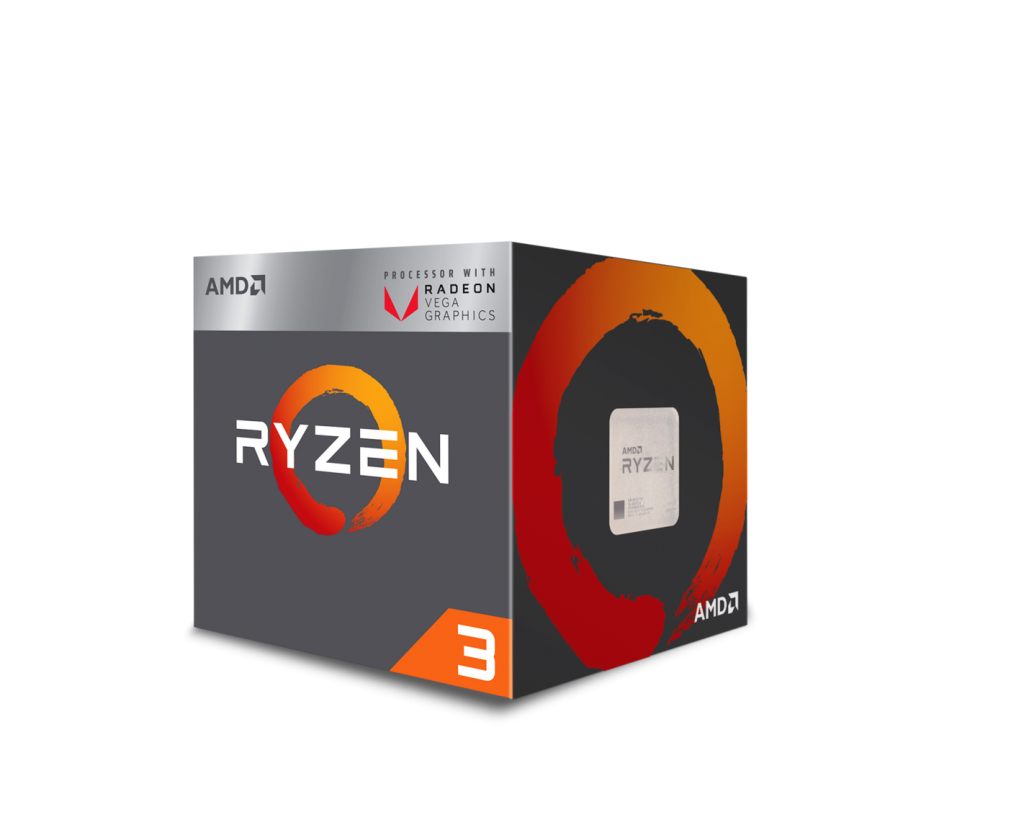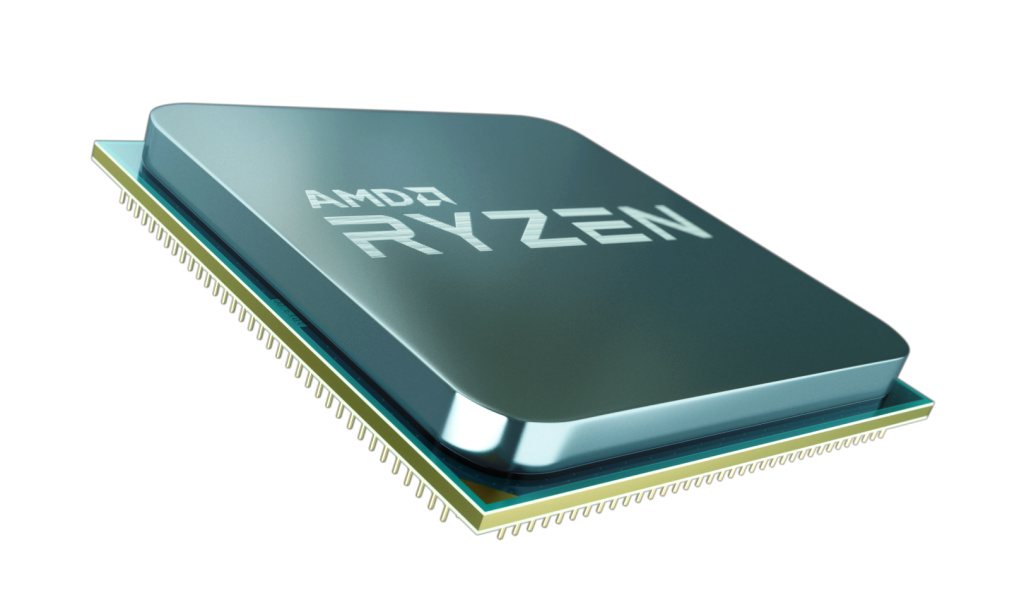ครั้งแรกของ AMD Ryzen™ Desktop APUs กับกราฟิกที่ทรงพลังที่สุดในโลก
ครั้งแรกของ AMD Ryzen™ Desktop APUs กับกราฟิกที่ทรงพลังที่สุดในโลกบนเดสก์ท็อปโปรเซสเซอร์1 พร้อมวางจำหน่ายทั่วโลกแล้ววันนี้
เดสก์ท็อปโปรเซสเซอร์ใหม่ Quad-Core Ryzen™ 5 2400G และ Ryzen™ 3 2200G ผนวกรวมสถาปัตยกรรมประสิทธิภาพสูง Radeon “Vega” และ “Zen” ไว้บนชิปเดียวกัน
AMD Ryzen Desktop APUs มอบประสิทธิภาพในการเล่นเกมระดับเดียวกับคอนโซลที่มีความละเอียดสูง2 บนเดสก์ท็อปของคุณ และกราฟิกที่ทรงประสิทธิภาพไม่แพ้ใครในราคาเริ่มต้นเพียง 3,690 บาท
กรุงเทพฯ, ประเทศไทย – 13 กุมภาพันธ์ 2561 – AMD (NASDAQ: AMD) ส่งกราฟิกการ์ดสำหรับเดสก์ทอปโปรเซสเซอร์ที่ทรงประสิทธิภาพที่สุดในโลกออกสู่ตลาด ด้วยการเปิดตัวด้วยโปรเซสเซอร์ Ryzen™ Desktop สองรุ่นที่ใช้กราฟิกการ์ด Radeon™ Vega ในตัว1 พร้อมจำหน่ายแล้ววันนี้ ประกอบด้วยโปรเซสเซอร์ AMD Ryzen™ 5 2400G และ AMD Ryzen™ 3 2200G ซึ่งเป็นการรวมพลังระหว่างสถาปัตยกรรม “Zen” รุ่นล่าสุดกับสถาปัตยกรรม Radeon “Vega” ในการออกแบบการวางระบบบนชิปเซ็ตเดียวกัน นำเสนอความเป็นผู้นำด้านระบบ และประสิทธิภาพด้านกราฟิก3 ในอีกระดับที่ราคา 5,990 บาท และราคา 3,690 บาท ตามลำดับ
จิม แอนเดอร์สัน รองประธานอาวุโส และผู้จัดการทั่วไป ฝ่ายคอมพิวติ้ง และกราฟิกของ AMD กล่าวว่า “การเปิดตัวโปรเซสเซอร์ Ryzen รุ่นแรกของเราเมื่อปีที่ผ่านมา เป็นการเริ่มผลักดันนวัตกรรม และการแข่งขันเข้าสู่ตลาดพีซี เรายังคงทุ่มเทต่อเนื่องในปี้นี้ ด้วยการเสริมสร้างความแข็งแกร่งให้กับผลิตภัณฑ์ Ryzen โดยการเพิ่มผลิตภัณฑ์ APU ใหม่อีกสองตัวเพื่อตอบสนองความต้องการที่หลากหลายของผู้ใช้พีซีในปัจจุบัน AMD Ryzen Desktop APUs เป็นตัวอย่างของนวัตกรรมที่สมบูรณ์แบบที่เราจะนำเสนอสู่ตลาดสำหรับผู้บริโภค และกลุ่มผู้ใช้ในเชิงพาณิชย์ การผสมผสานของสถาปัตยกรรม CPU และ GPU ประสิทธิภาพสูง ได้รับการออกแบบมาเพื่อมอบประสบการณ์การประมวลผลที่ราบรื่น รวมไปถึงความเพลิดเพลินในการเล่นเกมความละเอียดสูงในระดับ 1080p การเล่นเกมในระดับอีสปอร์ต หรือการแสดงผลทางหน้าจอที่สวยงาม เมื่อใช้ร่วมกับเทคโนโลยีแสดงผลขั้นสูงของกราฟิกการ์ด Radeon Vega ที่อยู่ในโปรเซสเซอร์”
ด้วยฟีเจอร์ขั้นสูงที่จะช่วยเพิ่มประสิทธิภาพของ Ryzen บนชิปเซ็ต APU ด้วยเทคโนโลยี AMD SenseMI ที่ได้รับการปรับปรุงใหม่4 ช่วยให้ Ryzen Desktop APUs ใช้พลังงานน้อยลงที่ระดับความถี่ที่สูงขึ้น และช่วยลดลาเทนซีของหน่วยความจำ APU รุ่นใหม่นี้ ยังรองรับเทคโนโลยี Precision Boost 2 ซึงเป็นอัลกอริทึ่มแบบมัลติคอร์ที่จะช่วยให้ความถี่ในแกนของ CPU สูงขึ้นในด้านการเล่นเกม และแอปพลิเคชันต่างๆ และด้วยกราฟิกการ์ดที่อยู่ข้างในชิปเซ็ต ทำให้สามารถทำงานร่วมกันกับเทคโนโลยี Radeon™ FreeSync และการแสดงผลในด้านการเล่นเกมได้อย่างราบรื่น 5
การประมวลผลประสิทธิภาพสูง
ประสิทธิภาพของโปรเซสเซอร์ Ryzen 5 2400G
- AMD เพียงโปรเซสเซอร์เดียวนี้ มีประสิทธิภาพเทียบเท่ากับการนำเกมมิ่ง CPU Intel Core i5-8400 ที่มีราคา 6,790 บาท
มารวมกับ NVIDIA GeForce GT 1030 ที่มีราคา 2,890 บาท6
- ประสิทธิภาพด้านกราฟิกที่สูงกว่า Intel Core i5-8400 ถึง 156%7
- ประสิทธิภาพทั้งระบบที่สูงกว่า Intel Core i5-8400 ถึง 21%8
- เมื่อโอเวอร์คล็อกสามารถเพิ่มประสิทธิภาพด้านกราฟิกได้ถึง 39%9
ความเข้ากันได้ของระบบภายใน
Ryzen Desktop APUs รองรับโครงสร้างพื้นฐาน Socket AM4 เช่นเดียวกันกับ Ryzen™ Desktop CPUs ดังนั้นจึงทำให้สามารถทำงานร่วมกันได้ในเมนบอร์ดระบบ AM4 ที่มีมากกว่า 120 รุ่น เพียงแค่อัพเดตไบออสเท่านั้น ซึ่งนับเป็นการสานต่อคำสัญญาของ AMD ในการสร้างประสบการณ์การใช้งานที่ดีให้กับลูกค้าอย่างต่อเนื่อง
ปลดล็อกด้านประสิทธิภาพ
เช่นเดียวกันกับโปรเซสเซอร์ AMD Ryzen Desktop ทุกรุ่น Ryzen Desktop APUs จะสามารถปลดล็อกเพื่อปรับแต่งประสิทธิภาพการทำงานของ CPU, DRAM และ GPU ผ่านทางซอฟต์แวร์โอเวอร์คล็อกอย่าง AMD Ryzen™ Master เพื่อให้ผู้ใช้ได้รับประสิทธิภาพ และมีอิสระในการโอเวอร์คล็อกได้ดียิ่งขึ้น10
การวางจำหน่าย
โปรเซสเซอร์ Ryzen Desktop ที่มาพร้อมกราฟิกการ์ด Radeon Vega พร้อมวางจำหน่ายแล้วทั่วโลกผ่านทางตัวแทนจำหน่ายออนไลน์ และร้านค้าปลีก เพื่อนำมาใช้กับเมนบอร์ด AM4 ที่มีวางจำหน่ายทั่วไปในตลาด และสำหรับเหล่าผู้ผลิตชั้นนำกับโปรเซสเซอร์ Ryzen Desktop พร้อมด้วยกราฟิกการ์ด Radeon Vega คาดว่าจะวางจำหน่ายในตลาดในอีกไม่กี่เดือนข้างหน้า ลูกค้าสามารถตรวจสอบข้อมูล และราคาล่าสุดของผลิตภัณฑ์ AMD Ryzen Desktop APUs ที่เว็บไซต์ AMD.com ได้แล้ววันนี้
Ryzen Desktop Processors with Radeon Vega Graphics:
| Model | CPU Cores | Threads | Max Boost Clock (GHz) | Graphics Compute Units[1] | Max GPU Clock (MHz) | L2/L3 Cache (MB) | TDP (Watts) | Suggested Price |
| Ryzen™ 5 2400G
with Radeon™ RX Vega 11 Graphics |
4 | 8 | 3.9 | 11 | 1250 | 6 | 65W | THB5,990 |
| Ryzen™ 3 2200G
with Radeon™ Vega 8 Graphics |
4 | 4 | 3.7 | 8 | 1100 | 6 | 65W | THB3,690 |
Supporting Resources
- Learn more about AMD Ryzen Desktop Processors with Radeon Vega Graphics at com/Ryzen
- Learn more about the “Zen” core architecture at com/Zen
- Learn more about AMD SenseMI Technology at com/en/technologies/sense-mi
- Learn more about Radeon FreeSync Technology at com/en/technologies/free-sync
- Learn more about AMD Products, Solutions, and Innovations
- Become a fan of AMD on Facebook
- Follow AMD on Twitter@AMD
เกี่ยวกับ AMD
เป็นเวลากว่า 45 ปีที่ AMD ขับเคลื่อนให้เกิดนวัตกรรมที่มีประสิทธิภาพสูงทั้งในส่วนของการประมวลผลกราฟิก และเทคโนโลยีเวอร์ชวลไลเซชั่นต่างๆ ซึ่งเป็นส่วนสำคัญสำหรับวงการเกม เป็นแพลตฟอร์มระดับมืออาชีพ และเป็นศูนย์กลางข้อมูล ผู้บริโภคหลายร้อยล้านคน องค์กรธุรกิจชั้นนำที่จัดอยู่ในกลุ่ม Fortune 500 และหน่วยงานวิจัยทางวิทยาศาสตร์สมัยใหม่ทั่วโลก ต่างใช้เทคโนโลยีของ AMD เพื่อการพัฒนาศักยภาพด้านต่างๆ ไม่ว่าจะเป็น การใช้ชีวิต การทำงาน และความบันเทิง พนักงานของ AMD ทุกคนทั่วโลกล้วนมุ่งพัฒนาผลิตภัณฑ์ใหม่ๆ ที่จะก้าวข้ามขอบเขตของข้อจำกัดทั้งหลาย ท่านสามารถดูข้อมูลเพิ่มเติมเกี่ยวกับ AMD (NASDAQ: AMD) และกระบวนการสร้างสรรค์ต่างๆ ที่เราทำในปัจจุบันและที่กำลังจะเกิดขึ้นในอนาคตได้ที่เว็บไซต์ http://www.amd.com/en-us
- บล็อก https://community.amd.com/welcome
- เฟซบุ๊ค https://www.facebook.com/AMDThailandOfficial/?brand_redir=23542086472
- ทวิตเตอร์ https://twitter.com/amd
Cautionary Statement
This press release contains forward-looking statements concerning Advanced Micro Devices, Inc. (AMD) including the features, functionality, availability, timing, deployment, and expected benefits of the Ryzen™ 5 2400G and AMD Ryzen™ 3 2200G processors as well as AMD’s 2018 product portfolio, which are made pursuant to the Safe Harbor provisions of the Private Securities Litigation Reform Act of 1995. Forward-looking statements are commonly identified by words such as “would,” “intends,” “believes,” “expects,” “may,” “will,” “should,” “seeks,” “intends,” “plans,” “pro forma,” “estimates,” “anticipates,” or the negative of these words and phrases, other variations of these words and phrases or comparable terminology. Investors are cautioned that the forward-looking statements in this document are based on current beliefs, assumptions and expectations, speak only as of the date of this document and involve risks and uncertainties that could cause actual results to differ materially from current expectations. Such statements are subject to certain known and unknown risks and uncertainties, many of which are difficult to predict and generally beyond AMD’s control, that could cause actual results and other future events to differ materially from those expressed in, or implied or projected by, the forward-looking information and statements. Material factors that could cause actual results to differ materially from current expectations include, without limitation, the following: Intel Corporation’s dominance of the microprocessor market and its aggressive business practices may limit AMD’s ability to compete effectively; AMD has a wafer supply agreement with GF with obligations to purchase all of its microprocessor and APU product requirements, and a certain portion of its GPU product requirements, from GLOBALFOUNDRIES Inc. (GF) with limited exceptions. If GF is not able to satisfy AMD’s manufacturing requirements, its business could be adversely impacted; AMD relies on third parties to manufacture its products, and if they are unable to do so on a timely basis in sufficient quantities and using competitive technologies, AMD’s business could be materially adversely affected; failure to achieve expected manufacturing yields for AMD’s products could negatively impact its financial results; the success of AMD’s business is dependent upon its ability to introduce products on a timely basis with features and performance levels that provide value to its customers while supporting and coinciding with significant industry transitions; if AMD cannot generate sufficient revenue and operating cash flow or obtain external financing, it may face a cash shortfall and be unable to make all of its planned investments in research and development or other strategic investments; the loss of a significant customer may have a material adverse effect on AMD; AMD’s receipt of revenue from its semi-custom SoC products is dependent upon its technology being designed into third-party products and the success of those products; global economic uncertainty may adversely impact AMD’s business and operating results; the markets in which AMD’s products are sold are highly competitive; AMD may not be able to generate sufficient cash to service its debt obligations or meet its working capital requirements; AMD has a large amount of indebtedness which could adversely affect its financial position and prevent it from implementing its strategy or fulfilling its contractual obligations; the agreements governing AMD’s notes and the Secured Revolving Line of Credit impose restrictions on AMD that may adversely affect its ability to operate its business; the products that AMD sells are complex and may be subject to security vulnerabilities that could result in, among other things, the loss, corruption or misuse of confidential data by unauthorized third parties or system performance issues. AMD’s efforts to prevent and address security vulnerabilities can be costly and may be partially effective or not successful at all; AMD’s issuance to West Coast Hitech L.P. (WCH) of warrants to purchase 75 million shares of its common stock, if and when exercised, will dilute the ownership interests of its existing stockholders, and the conversion of the 2.125% Convertible Senior Notes due 2026 may dilute the ownership interest of its existing stockholders, or may otherwise depress the price of its common stock; uncertainties involving the ordering and shipment of AMD’s products could materially adversely affect it; the demand for AMD’s products depends in part on the market conditions in the industries into which they are sold. Fluctuations in demand for AMD’s products or a market decline in any of these industries could have a material adverse effect on its results of operations; AMD’s ability to design and introduce new products in a timely manner is dependent upon third-party intellectual property; AMD depends on third-party companies for the design, manufacture and supply of motherboards, software and other computer platform components to support its business; if AMD loses Microsoft Corporation’s support for its products or other software vendors do not design and develop software to run on AMD’s products, its ability to sell its products could be materially adversely affected; and AMD’s reliance on third-party distributors and AIB partners subjects it to certain risks. Investors are urged to review in detail the risks and uncertainties in AMD’s Securities and Exchange Commission filings, including but not limited to AMD’s Quarterly Report on Form 10-Q for the quarter ended September 30, 2017.
—30—
“Vega” is a codename for an AMD graphics architecture and is not a product name.
AMD, the AMD Arrow logo, Ryzen, Radeon, FreeSync and combinations thereof, are trademarks of Advanced Micro Devices, Inc. Other names are for informational purposes only and may be trademarks of their respective owners.
1 Testing by AMD Performance labs as of 12/08/2017 for the Ryzen 5 2400G, and 09/04/2015 for the Core i7-5775c on the following systems. PC manufacturers may vary configurations yielding different results. Results may vary based on driver versions used. System Configs: All systems equipped with Samsung 850 PRO 512GB SSD, Windows 10 RS2 operating system. Socket AM4 System: Ryzen 52400G processor, 16B (2 x 8GB) DDR4-2667 RAM, Graphics Driver 1710181048-17.40-171018a-319170E 23.20.768.0 :: 12/08/2017. Socket LGA1150 System: Core i7-5775c processor, 8GB (2x4GB) DDR3-1867 MHz RAM, graphics driver 10.18.15.4256:: 09/04/2015. 3DMark 11 Performance benchmark used to represent graphics power. The following processors achieved the following scores in 3DMark 11 ‘performance’ benchmark v1.0.132.0: The Ryzen 5 2400G: 5042. Also in v1.0.132.0, .The Core i7-5775c, the Intel desktop processor with the highest Intel desktop graphics performance, achieved 3094. RZG-01
2 Testing by AMD Performance labs as of 11/13/2017 on the following systems. PC manufacturers may vary configurations yielding different results. Results may vary based on driver versions used.
System Configs: All systems equipped with 16B (2 x 8GB) DDR4-2667 RAM, Samsung 850 PRO 512GB SSD, Windows 10 RS2 operating system,:: 11/13/2017. Socket AM4 System: Ryzen 3 2200G processor, Graphics Driver 1710181048-17.40-171018a-319170E 23.20.768.0 :: Socket LGA1150 System: Core i3-8100 processor, graphics driver 15.47.02.4815 ::Console-Class Performance, and true 1080p HD+ gaming performance, defined as playable +30 FPS average at 1080p, low-to-high settings. The Ryzen 5 2400G achieved the following frame rates in the following games at 1080p: Battlefield 1 (Low Dx11), 54 FPS; DOTA2 (Med-Vulkan), 72 FPS; Overwatch (Low-Hollywood), 58 FPS; The Ryzen 3 2200G achieved the following frame rates in the following games at 1080p: Battlefield 1 (Low Dx11), 44 FPS; DOTA2 (Med-Vulkan), 69 FPS; Overwatch (Low-Hollywood), 51 FPS. RZG-03
3 Testing by AMD Performance labs as of 01/02/2018. PC manufacturers may vary configurations yielding different results. Results may vary based on driver versions used. System Configs: All systems equipped with 16GB dual-channel DDR4 @ 2666 MHz, Samsung 850 PRO 512GB SSD, Windows 10 RS2 operating system. Socket AM4 System: AMD Ryzen 5 2400G, AMD Ryzen 3 2200G, Myrtle RV motherboard. Graphics driver 23.20.768.0 (17.40) :: (When GeForce GTX 1080 was used, graphics driver 23.21.13.8859 (38859)) :: 01/02/2018 Socket LGA1155 System: Core i5-8400, Core i3-8100, Z370 Aorus Gaming-5 motherboard, graphics driver 23.20.16.4849.:: 01/02/2018 The Core i3-8100 Achieved 2914 in PCMark 10 Extended. The Core i5-8400 achieved 2976 in PCMark 10 Extended; and in SpecViewperf, it achieved the following scores: Catia, 15.22; Creo, 12.36; Energy, 0.26; Maya, 14.82; Medical, 3.7; Showcase, 7; SNX, 4; SW, 29 The Ryzen 3 2200G achieved 3300 in PCMark 10 Extended; and in SpecViewperf, it achieved the following scores: Catia, 17.48; Creo, 23.07; Energy, 0.41; Maya, 17.78; Medical, 5.93; Showcase, 11.49; SNX, 10.62; SW, 35.18 The Ryzen 5 2400G achieved 3590 in PCMark 10 Extended; and in SpecViewperf, it achieved the following scores: Catia, 21.56(/15.22=142% of the Core i5-8400); Creo, 26.02(/12.36=211% of the Core i5-8400); Energy, 0.50(/0.26=193% of the Core i5-8400); Maya, 21.35(/14.82=144% of the Core i5-8400); Medical, 9.02(/3.7=244% of the Core i5-8400); Showcase, 12.42(/7=166% of the Core i5-8400); SNX, 12.17(/4=323% of the Core i5-8400); SW, 40.07(/29=138% of the Core i5-8400) . RZG-10
4 AMD SenseMI technology is built into all Ryzen processors, but specific features and their enablement may vary by product and platform. Learn more at http://www.amd.com/en/technologies/sense-mi. GD-126
5 Requires a monitor and AMD Radeon™ graphics, both with FreeSync support. Seewww.amd.com/freesync for complete details. Confirm capability with your system manufacturer before purchase. GD-127
6 Testing by AMD Performance labs as of 01/05/2018 on the following system. PC manufacturers may vary configurations yielding different results. Results may vary based on driver versions used. System Configs: 16GB DDR4-3200, Samsung 950 PRO SSD, Windows 10 RS2. Socket AM4 System: AMD Ryzen 5 2400G ($169 USD SEP, 65W TDP), Turpan motherboard. Graphics driver 23.20.768.0 (17.40):: 01/05/2018 . Socket LGA1155 System: Core i5-8400 ($199 on Newegg as of Jan 5, 2018, 65W TDP), Z370 Aorus Gaming-5 motherboard, graphics driver 23.20.16.4849.(with GeForce GTX 1030 ($89 on Newegg as of Jan 5, 2018, 30W TDP) – graphics driver 23.20.16.4901) :: 01/05/2018.The Ryzen 5 2400G (with Radeon graphics) achieved 1231 in 3DMark Time Spy, and 3276 in 3DMark Fire Strike. The Core i5 8400 (using integrated graphics) achieved 419 in 3DMark Time Spy, and 1118 in 3DMark Fire Strike. The Core i5 8400 (using GeForce GTX 1030 graphics) achieved 1234 in 3DMark Time Spy, and 3349 in 3DMark Fire Strike. RZG-11
7 Based on testing of the AMD Ryzen™ 5 2400G, and Core i5-8400 mobile processors as of 12/21/2017. Performance based on 3DMark® Time Spy in order of AMD Ryzen™ 5 2400G and Intel i5-8400. 3DMark Time Spy results: 1096, 428 giving 1096/428 = 2.56X or 256% graphics performance or 156% more graphics performance. AMD Ryzen™ 2400G: AMD reference board, AMD Ryzen™ 2400G with Radeon™ RX Vega 11 Graphics, 16GB Dual Channel (2x8GB) DDR4-2667 RAM, Samsung 850 PRO 512GB SATA SSD, Windows 10 Pro RS3, Graphics driver 2.1.1 RC5 17.40 RC19, 12/6/2017
i5-8400: Z370 AORUS Gaming 5, i5-8400 with Intel UHD Graphics 630, 16GB Dual Channel (2x8GB) DDR4-2667 RAM, Samsung 850 PRO 512GB SATA SSD, Windows 10 Pro RS2, Graphics driver 15.47.02.4815. Different configurations and drivers may yield different results. RZG-04
8 Based on testing of the AMD Ryzen™ 5 2400G, and Core i5-8400 mobile processors as of 12/21/2017. Performance based on PCMark® 10 Extended in order of AMD Ryzen™ 5 2400G and Intel i5-8400. PCMark 10 Extended results: 3590, 2976 giving 3590/2973 = 1.21X or 121% system performance or 21% more graphics performance. AMD Ryzen™ 2400G: AMD reference board, AMD Ryzen™ 2400G with Radeon™ RX Vega 11 Graphics, 16GB Dual Channel (2x8GB) DDR4-2667 RAM, Samsung 850 PRO 512GB SATA SSD, Windows 10 Pro RS3, Graphics driver 2.1.1 RC5 17.40 RC19, 12/6/2017
i5-8400: Z370 AORUS Gaming 5, i5-8400 with Intel UHD Graphics 630, 16GB Dual Channel (2x8GB) DDR4-2667 RAM, Samsung 850 PRO 512GB SATA SSD, Windows 10 Pro RS2, Graphics driver 15.47.02.4815. Different configurations and drivers may yield different results. RZG-05
9 Testing by AMD Performance labs as of 12/22/2017 on the following system. PC manufacturers may vary configurations yielding different results. Results may vary based on driver versions used.
System Configs: AMD Ryzen 5 2400G, Gigabyte B350 Mini-ITX motherboard, 16GB of dual-channel DDR3-3200, and a Samsung 950 PRO M.2 boot drive. Graphics driver 23.20.768.0 (17.40) :: 12/22/2017 The Ryzen 5 2400G achieved the following scores in 3DMark Fire Strike when using the following configurations: With stock GPU clocks and DDR4-2400, the system achieved 2911 points. With stock GPU clocks and DDR4-3200, the system achieved 3322 points. With a 1550 MHz GPU clock and DDR4-3200, the system achieved 3596 points. With a 1675 MHz GPU clock and DDR4-3600, the system achieved 4048 points (4048/2911=139%, or 39% higher than the stock GPU clock with 2400 MHz DDR4 memory). RZG-06
10 Overclocking memory will void any applicable AMD product warranty, even if such overclocking is enabled via AMD hardware and/or software. This may also void warranties offered by the system manufacturer or retailer or motherboard vendor. Users assume all risks and liabilities that may arise out of overclocking memory, including, without limitation, failure of or damage to RAM/hardware, reduced system performance and/or data loss, corruption or vulnerability. GD-112 AMD’s product warranty does not cover damages caused by overclocking, even when overclocking is enabled via AMD hardware and/or software . GD-26
11 AMD Radeon™ and FirePro™ GPUs based on the Graphics Core Next architecture consist of multiple discrete execution engines known as a Compute Unit (“CU”). Each CU contains 64 shaders (“Stream Processors”) working together. GD-78




